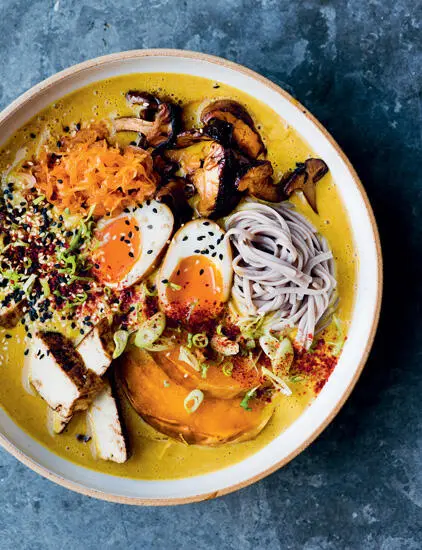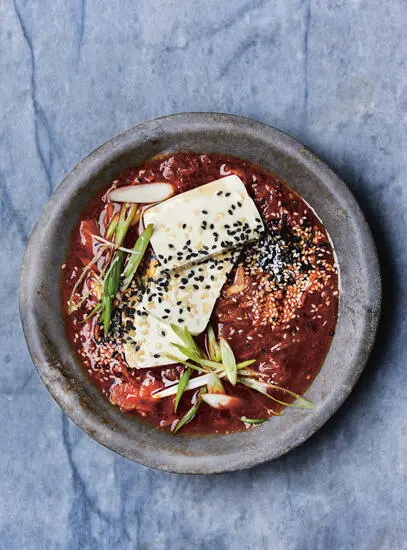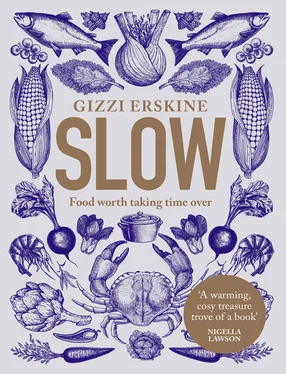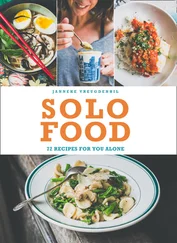1 tsp sesame seeds
In a medium casserole, heat the oil over a medium heat and add the onion. Allow to soften for about 15 minutes to develop their sweet flavour before adding the garlic and ginger. Sweat for a further 3–4 minutes before adding the spices. Next add the soy bean chilli oil and give this a couple of minutes on the heat, before adding the water. Whisk in the miso paste, followed by the mirin, nutritional yeast, Marmite, soy and sugar. Allow the sauce to reduce on a low simmer for 30 minutes and then add the soy milk. Transfer to a food processor and blitz until smooth, then return to the pan.
Meanwhile in a frying pan heat a glug of oil and fry the mushrooms over a high heat for 5 minutes until they start to caramelise, then set aside. Return the pan to the heat, add a little extra oil if necessary, ramp up the heat and fry the tofu for a minute on each side, or until really charred. Put the teriyaki sauce in a bowl, add the tofu and the eggs and coat thoroughly. Set to one side.
When ready to serve, divide the noodles between two ramen bowls and pour a quarter of the soup base into each bowl. Slice the eggs in half and place on top. Slice the tofu into strips and arrange next to the eggs, followed by the butternut squash and kimchi. Finally, sprinkle the spring onions, chilli powder and sesame seeds over the top and serve immediately.

Souped-up Kimchi Jjigae
A few years ago, I lived in Korea for almost six months while filming a show about Korean food. So believe me when I say Koreans live on kimchi – they have it for breakfast, lunch and dinner. But if you ask any Korean what their favourite dish is, they will all say jjigae. A jjigae is a stew and it’s the heart of Korean home cooking. Most people love Doenjang Jjigae which is made with the famous Korean miso paste, but the real red-blooded Korean loves Kimchi Jjigae with its gochujang spiced base and heaps of shredded kimchi. Classically it is made with pork belly, but the Buddhists (who abstain from groin-rumbling fiery chillies) make it without so it can be made vegan with vegan kimchi. The reason this is souped-up is because, although the Koreans call it a stew, I’ve made it a little more brothy. If you want to add carbs you can cook some Korean sweet potato glass noodles and add them to the base.
SERVES 4
Preparation time 20 minutes
Cooking time 30 minutes
splash of rapeseed oil
100g pork belly, thinly sliced or unsmoked bacon (omit if vegetarian)
2 onions, thinly sliced
1 tbsp gochujang paste if you like it spicy or 1 tbsp doenjang paste if you prefer it milder
2 garlic cloves, grated
2cm piece of ginger, peeled and grated
1–2 tbsp Korean chilli powder
1 litre fresh chicken or vegetable stock
400g kimchi, shredded
300g silken tofu, drained and cut into 12 slices
3 spring onions, finely chopped sesame seeds and toasted sesame oil, to serve
First heat a deep-sided frying pan over a high heat. Add a splash of oil followed by the pork belly or bacon. You want to render some of the fat and crisp it up, so fry it for about 8 minutes, moving it around the pan regularly. Once the pork is looking nice and caramelised, remove it with a slotted spoon and set aside. Add the onions to the pork fat and fry for about 5 minutes until they begin to soften and go translucent. (If you are making a vegetarian version, omit this stage and just fry the onions in a little rapeseed oil.)
Next add the spice paste of your choice. I prefer gochujang as I like a bit of extra kick, but you can get a great complexity of flavour from doenjang paste. Give this a stir and add the garlic, ginger and chilli powder and allow to sweat for a few minutes before adding the pork belly. After a couple more minutes pour in the stock. Bring this to the boil and allow to simmer for about 15 minutes. Finally, add the kimchi and simmer for a further 10 minutes.
When you are ready to serve, divide the soup between four bowls. Layer 3 slices of tofu per person on top of the soup, along with a sprinkling of spring onions, sesame seeds and a drizzle of toasted sesame oil.

Jewish Chicken Soup
I love Jewish culture. Although I was not brought up within a religion, I think it’s probably ingrained in me because of my grandparents. My grandmother was from Scotland and flitted between Communism and Buddhism before marrying a Pole who had escaped Nazi Poland during the war. My grandfather (who worked as a pharmacist, exporting pharmaceuticals back into a bleak post-war Poland) wasn’t religious, not after all the atrocities he’d seen during the war, but he was brought up as a Jew before converting to Catholicism to escape Nazi rule. As a result, a lot of Jewish and Polish foods slipped into the meals we ate – and still eat – as a family.
Most of you will have tried a classic Jewish noodle soup, otherwise known as Jewish penicillin, thanks to its fabled power to cure every ailment. The soup is often served with matzo balls: dumplings made from fine crumbs of matzo crackers, which are a bit like water biscuits. They are sturdy little balls and make the soup much more filling. I am a greedy guts, so I like to serve my soup with kreplach dumplings too.
Most Jewish friday night suppers start with a hot bowl of this soup. I make mine with both a whole chicken and a really good chicken stock. Some might argue that you don’t need the chicken stock as the chicken will make its own soup, but for me there is never enough stock by the time it’s reduced. Always use fresh stock.
SERVES 6, DEPENDING ON HOW HUNGRY YOU ARE
Preparation time 15 minutes
Cooking time 2 hours
1 large chicken of the best quality and ethical standing you can afford
2 medium onions, halved
2 large carrots, left whole
1 leek, trimmed but left whole handful of celery leaves
3 bay leaves
few sprigs of thyme
2–3 sprigs of rosemary
500g fresh chicken stock (from the chiller cabinet)
1 tsp black peppercorns
½ tsp salt
sea salt and freshly ground black pepper
To serve (per person)
 of the soup
of the soup
30g Jewish noodles or vermicelli
2 matzo balls ( see here)
3 kreplach ( see here)
dill sprigs
Place the chicken in the largest pot you have. You need about 3cm of space around the edges of the chicken and about 3cm of depth above it so it can be totally immersed in liquid. Lay the vegetables and herbs around the chicken, then pour over the stock. Top up with water if necessary so the chicken is totally covered. Add the peppercorns and salt. Cover and allow to poach gently on a low simmer for 1 hour 30 minutes.
When cooked, very carefully remove the chicken and set it aside. Remove the carrots and onion halves, set them aside to cool with the chicken for 15 minutes, then chop them up. I like the chicken meat torn into small bite-size pieces, the onions finely chopped and the carrots more roughly chopped. You can use the rest of the veg, though classically the soup is only served with carrots. There will be a fair bit of chicken meat and I sometimes keep a breast for making sandwiches. Put the meat on one side while you make the broth.
Strain the vegetables, herbs and peppercorns from the stock. Clean, rinse and dry the pot and pour the stock back into it. Bring to the boil. Reduce it for about 15 minutes, or until the broth has a really intense chicken flavour. You should end up with about 3 litres of really flavoursome broth. Keep reducing it until the flavour is right. Season with salt and pepper, return the chicken meat, carrots and onions to the pan and bring back to the boil.
Читать дальше



 of the soup
of the soup










